Do you have a question about the Panasonic TH-42PA60A and is the answer not in the manual?
Specifies the AC voltage and frequency requirements for operation.
Details the average and standby power usage for different screen sizes.
Covers drive method, aspect ratio, contrast ratio, and pixel dimensions.
Lists speaker dimensions and audio output power specifications.
Outlines the supported broadcast systems and band names for different models.
Table detailing signal names, horizontal, and vertical frequencies for various inputs.
Provides general recommendations for safe servicing and handling.
Explains the procedure for measuring touch current to ensure safety.
Lists methods to prevent damage from electrostatic discharge to sensitive components.
Discusses the properties and handling precautions for lead-free solder.
Identifies major internal boards and their respective functions within the chassis.
Step-by-step instructions for removing the back cover, tuner cover, P-Board, and PA-Board.
Details the removal process for the tuner unit, DG-Board, TA-Board, and H-Board.
Instructions for removing HC-Board, D-Board, and SU-Board.
Steps for removing SD-Board, SC-Board, and SS-Board from the chassis.
Instructions on how to remove the C1-Board and C2-Board assemblies.
Procedures for detaching the speakers and the S-Board from the unit.
Steps for removing K-Board, stand brackets, and the plasma panel from the front frame.
Detailed steps for installing the replacement plasma panel and reassembling the unit.
Illustrates the dressing and routing of specific wiring leads within the chassis.
Shows the dressing and connection points for a second set of wiring leads.
Details the routing and connection of a third set of internal wiring.
Illustrates the dressing and connection of a fourth set of wiring leads.
Shows the dressing and connection points for a fifth set of internal wiring.
Details the routing and connection of a sixth set of wiring leads.
Describes the self-check procedure, including memory and component status checks.
Explains how power LED blink patterns indicate specific circuit abnormalities.
Outlines the diagnostic steps for identifying the cause of a "No Power" condition based on LED status.
Provides a flowchart for diagnosing "No Picture" issues based on OSD and board checks.
Details how to identify local screen failures and the potentially affected PCBs.
Instructions on how to access SERVICE 1 mode using sound menu settings and button presses.
Steps to enter SERVICE 2 mode by setting channel, EQ, and pressing the HOLD button.
Explains the function of various options that can be adjusted in service mode for different models.
Details the necessary preparations, including input signals and picture settings, before performing adjustments.
Guides on checking and adjusting driver section voltages using a multimeter based on panel data.
Instructions for adjusting the initialization pulse using an oscilloscope and VR6602.
Cautions for PCB removal and procedures for quick voltage adjustments after replacement.
Diagram showing the location of adjustment potentiometers on the P-Board.
Diagram illustrating the location of various test points on the P-Board.
Detailed procedure for adjusting white balance for PAL signals using a color analyzer.
Procedure for adjusting white balance for HD signals using a color analyzer.
Instructions for adjusting the sub-bright level using the service mode and a gray-scale pattern.
Procedure for adjusting the Automatic Brightness Limiter (ABL) based on power consumption.
Procedures for adjusting sub-contrast for AV, RF, and HD systems using signal generators.
Explains the purpose of hotel mode, how to access it, and the configuration options available.
Illustrates the component placement and routing on the P-Board for 37-inch models.
Shows the component placement and routing on the P-Board for 42-inch models.
Diagram showing the conductor layout and component placement on the PA-Board.
Shows conductor layouts and parts location for H, HC, and TA boards.
Illustrates the conductor layouts and parts location for the K-Board and S-Board.
Shows conductor layouts and parts location for the DG-Board.
Illustrates the conductor layouts and parts location for the D-Board.
Shows the conductor layout and component placement on the C1-Board for 37-inch models.
Illustrates the conductor layout and component placement on the C1-Board for 42-inch models.
Shows the conductor layout and component placement on the C2-Board for 37-inch models.
Illustrates the conductor layout and component placement on the C2-Board for 42-inch models.
Shows the conductor layout and component placement on the SC-Board.
Illustrates the conductor layout and component placement on the SU-Board for 37-inch models.
Shows the conductor layout and component placement on the SU-Board for 42-inch models.
Illustrates the conductor layout and component placement on the SD-Board for 37-inch models.
Shows the conductor layout and component placement on the SD-Board for 42-inch models.
Illustrates the conductor layout and component placement on the SS-Board.
Explains symbols, abbreviations, and safety precautions for schematic diagrams.
Provides a high-level overview of the TV's functional blocks and their interconnections.
Detailed block diagram showing the P-Board's internal functions and connections for 37-inch models.
First part of the P-Board schematic, detailing power supply and related circuits.
Second part of the P-Board schematic, focusing on voltage regulation and control circuits.
Third part of the P-Board schematic, illustrating protection and control circuitry.
Fourth part of the P-Board schematic, showing power management and error detection circuits.
Fifth part of the P-Board schematic, detailing control and interface circuits.
Sixth part of the P-Board schematic, showing power supply output and regulation circuits.
Block diagram of the P-Board for 42-inch models, illustrating internal functions and connections.
First section of the P-Board schematic for 42-inch models, covering power supply.
Second section of the P-Board schematic for 42-inch models, detailing voltage regulation.
Third section of the P-Board schematic for 42-inch models, showing protection and control circuits.
Fourth section of the P-Board schematic for 42-inch models, illustrating power management.
Fifth section of the P-Board schematic for 42-inch models, detailing control and interface circuits.
Sixth section of the P-Board schematic for 42-inch models, showing output circuits.
Block diagram illustrating the functions and interconnections of the PA-Board components.
First part of the PA-Board schematic, showing power and control circuits.
Second part of the PA-Board schematic, detailing audio and speaker drive circuits.
Block diagram showing the interconnections between H, K, and TA boards for signal processing.
Block diagram illustrating the functions of the HC-Board, including jig connections and interface signals.
First section of the H-Board schematic, showing input/output terminals and basic signal paths.
Second section of the H-Board schematic, detailing signal processing and data flow.
Third section of the H-Board schematic and the complete K-Board schematic, showing interface and control signals.
Schematic diagrams for the HC-Board and TA-Board, showing their respective circuits and connections.
Block diagram illustrating the main functions of the DG-Board, including HDMI interface and signal processing.
Second part of the DG-Board block diagram, showing MICOM, digital signal processing, and interface connections.
Third part of the DG-Board block diagram, detailing memory interfaces and various input/output signals.
First section of the DG-Board schematic, showing memory and interface circuits.
Second section of the DG-Board schematic, detailing the MICOM and signal processing circuits.
Third section of the DG-Board schematic, showing interface circuits and various signal routing.
Fourth section of the DG-Board schematic, illustrating analog-to-digital converters and signal processing.
Fifth section of the DG-Board schematic, detailing HDMI interface and I/O converters.
Sixth section of the DG-Board schematic, showing signal routing and interface logic.
Seventh section of the DG-Board schematic, illustrating memory interfaces and control signals.
Eighth section of the DG-Board schematic, showing JTAG interface and final connections.
Block diagram of the D-Board, detailing format conversion, plasma AI, and driver control functions.
First section of the D-Board schematic, showing memory interfaces and signal processing.
Second section of the D-Board schematic, detailing MICOM and A/D converter circuits.
Third section of the D-Board schematic, showing LVDS transmission and interface logic.
Fourth section of the D-Board schematic, illustrating memory interfaces and control signals.
Fifth section of the D-Board schematic, showing memory and LVDS interface configurations.
Sixth section of the D-Board schematic, detailing memory interfaces and termination.
Block diagrams for the C1 and C2 boards, showing their roles in data driving and buffering.
First part of the C1-Board schematic for 37-inch models, illustrating LVDS data transmission.
Second part of the C1-Board schematic for 37-inch models, showing buffer and interface circuits.
First part of the C1-Board schematic for 42-inch models, illustrating LVDS data transmission.
Second part of the C1-Board schematic for 42-inch models, showing buffer and interface circuits.
First part of the C2-Board schematic for 37-inch models, illustrating LVDS data transmission.
Second part of the C2-Board schematic for 37-inch models, showing buffer and interface circuits.
First part of the C2-Board schematic for 42-inch models, illustrating LVDS data transmission.
Second part of the C2-Board schematic for 42-inch models, showing buffer and interface circuits.
Block diagrams illustrating the functions of SC, SU, and SD boards for scan drive and signal processing.
First part of the SC-Board schematic, showing power supply and driver circuits.
Second part of the SC-Board schematic, detailing scan drive and output circuits.
Schematic diagram of the SU-Board for 37-inch models, showing scan drive and signal distribution.
Schematic diagram of the SU-Board for 42-inch models, illustrating scan drive and signal distribution.
Schematic diagram of the SD-Board for 37-inch models, showing scan drive and data output circuits.
Shows the conductor layout and component placement on the SD-Board for 42-inch models.
Block diagrams for SS and S-boards, detailing sustain drive, power switching, and LED control functions.
Exploded view showing the physical location of major components and boards within the chassis.
Illustrations detailing the first stage of packing the TV unit and accessories.
Further illustrations showing the second stage of packing the TV unit and its accessories.
Final illustrations detailing the third stage of packing the TV unit and accessories.
A list of mechanical parts with their part numbers, descriptions, and quantities required for replacement.
Important safety notes and guidelines regarding RTL (Retention Time Limited) for replacement parts.
A comprehensive list of electrical components with part numbers, descriptions, quantities, and remarks.
Specifies the AC voltage and frequency requirements for operation.
Details the average and standby power usage for different screen sizes.
Covers drive method, aspect ratio, contrast ratio, and pixel dimensions.
Lists speaker dimensions and audio output power specifications.
Outlines the supported broadcast systems and band names for different models.
Table detailing signal names, horizontal, and vertical frequencies for various inputs.
Provides general recommendations for safe servicing and handling.
Explains the procedure for measuring touch current to ensure safety.
Lists methods to prevent damage from electrostatic discharge to sensitive components.
Discusses the properties and handling precautions for lead-free solder.
Identifies major internal boards and their respective functions within the chassis.
Step-by-step instructions for removing the back cover, tuner cover, P-Board, and PA-Board.
Details the removal process for the tuner unit, DG-Board, TA-Board, and H-Board.
Instructions for removing HC-Board, D-Board, and SU-Board.
Steps for removing SD-Board, SC-Board, and SS-Board from the chassis.
Instructions on how to remove the C1-Board and C2-Board assemblies.
Procedures for detaching the speakers and the S-Board from the unit.
Steps for removing K-Board, stand brackets, and the plasma panel from the front frame.
Detailed steps for installing the replacement plasma panel and reassembling the unit.
Illustrates the dressing and routing of specific wiring leads within the chassis.
Shows the dressing and connection points for a second set of wiring leads.
Details the routing and connection of a third set of internal wiring.
Illustrates the dressing and connection of a fourth set of wiring leads.
Shows the dressing and connection points for a fifth set of internal wiring.
Details the routing and connection of a sixth set of wiring leads.
Describes the self-check procedure, including memory and component status checks.
Explains how power LED blink patterns indicate specific circuit abnormalities.
Outlines the diagnostic steps for identifying the cause of a "No Power" condition based on LED status.
Provides a flowchart for diagnosing "No Picture" issues based on OSD and board checks.
Details how to identify local screen failures and the potentially affected PCBs.
Instructions on how to access SERVICE 1 mode using sound menu settings and button presses.
Steps to enter SERVICE 2 mode by setting channel, EQ, and pressing the HOLD button.
Explains the function of various options that can be adjusted in service mode for different models.
Details the necessary preparations, including input signals and picture settings, before performing adjustments.
Guides on checking and adjusting driver section voltages using a multimeter based on panel data.
Instructions for adjusting the initialization pulse using an oscilloscope and VR6602.
Cautions for PCB removal and procedures for quick voltage adjustments after replacement.
Diagram showing the location of adjustment potentiometers on the P-Board.
Diagram illustrating the location of various test points on the P-Board.
Detailed procedure for adjusting white balance for PAL signals using a color analyzer.
Procedure for adjusting white balance for HD signals using a color analyzer.
Instructions for adjusting the sub-bright level using the service mode and a gray-scale pattern.
Procedure for adjusting the Automatic Brightness Limiter (ABL) based on power consumption.
Procedures for adjusting sub-contrast for AV, RF, and HD systems using signal generators.
Explains the purpose of hotel mode, how to access it, and the configuration options available.
Illustrates the component placement and routing on the P-Board for 37-inch models.
Shows the component placement and routing on the P-Board for 42-inch models.
Diagram showing the conductor layout and component placement on the PA-Board.
Shows conductor layouts and parts location for H, HC, and TA boards.
Illustrates the conductor layouts and parts location for the K-Board and S-Board.
Shows conductor layouts and parts location for the DG-Board.
Illustrates the conductor layouts and parts location for the D-Board.
Shows the conductor layout and component placement on the C1-Board for 37-inch models.
Illustrates the conductor layout and component placement on the C1-Board for 42-inch models.
Shows the conductor layout and component placement on the C2-Board for 37-inch models.
Illustrates the conductor layout and component placement on the C2-Board for 42-inch models.
Shows the conductor layout and component placement on the SC-Board.
Illustrates the conductor layout and component placement on the SU-Board for 37-inch models.
Shows the conductor layout and component placement on the SU-Board for 42-inch models.
Illustrates the conductor layout and component placement on the SD-Board for 37-inch models.
Shows the conductor layout and component placement on the SD-Board for 42-inch models.
Illustrates the conductor layout and component placement on the SS-Board.
Explains symbols, abbreviations, and safety precautions for schematic diagrams.
Provides a high-level overview of the TV's functional blocks and their interconnections.
Detailed block diagram showing the P-Board's internal functions and connections for 37-inch models.
First part of the P-Board schematic, detailing power supply and related circuits.
Second part of the P-Board schematic, focusing on voltage regulation and control circuits.
Third part of the P-Board schematic, illustrating protection and control circuitry.
Fourth part of the P-Board schematic, showing power management and error detection circuits.
Fifth part of the P-Board schematic, detailing control and interface circuits.
Sixth part of the P-Board schematic, showing power supply output and regulation circuits.
Block diagram of the P-Board for 42-inch models, illustrating internal functions and connections.
First section of the P-Board schematic for 42-inch models, covering power supply.
Second section of the P-Board schematic for 42-inch models, detailing voltage regulation.
Third section of the P-Board schematic for 42-inch models, showing protection and control circuits.
Fourth section of the P-Board schematic for 42-inch models, illustrating power management.
Fifth section of the P-Board schematic for 42-inch models, detailing control and interface circuits.
Sixth section of the P-Board schematic for 42-inch models, showing output circuits.
Block diagram illustrating the functions and interconnections of the PA-Board components.
First part of the PA-Board schematic, showing power and control circuits.
Second part of the PA-Board schematic, detailing audio and speaker drive circuits.
Block diagram showing the interconnections between H, K, and TA boards for signal processing.
Block diagram illustrating the functions of the HC-Board, including jig connections and interface signals.
First section of the H-Board schematic, showing input/output terminals and basic signal paths.
Second section of the H-Board schematic, detailing signal processing and data flow.
Third section of the H-Board schematic and the complete K-Board schematic, showing interface and control signals.
Schematic diagrams for the HC-Board and TA-Board, showing their respective circuits and connections.
Block diagram illustrating the main functions of the DG-Board, including HDMI interface and signal processing.
Second part of the DG-Board block diagram, showing MICOM, digital signal processing, and interface connections.
Third part of the DG-Board block diagram, detailing memory interfaces and various input/output signals.
First section of the DG-Board schematic, showing memory and interface circuits.
Second section of the DG-Board schematic, detailing the MICOM and signal processing circuits.
Third section of the DG-Board schematic, showing interface circuits and various signal routing.
Fourth section of the DG-Board schematic, illustrating analog-to-digital converters and signal processing.
Fifth section of the DG-Board schematic, detailing HDMI interface and I/O converters.
Sixth section of the DG-Board schematic, showing signal routing and interface logic.
Seventh section of the DG-Board schematic, illustrating memory interfaces and control signals.
Eighth section of the DG-Board schematic, showing JTAG interface and final connections.
Block diagram of the D-Board, detailing format conversion, plasma AI, and driver control functions.
First section of the D-Board schematic, showing memory interfaces and signal processing.
Second section of the D-Board schematic, detailing MICOM and A/D converter circuits.
Third section of the D-Board schematic, showing LVDS transmission and interface logic.
Fourth section of the D-Board schematic, illustrating memory interfaces and control signals.
Fifth section of the D-Board schematic, showing memory and LVDS interface configurations.
Sixth section of the D-Board schematic, detailing memory interfaces and termination.
Block diagrams for the C1 and C2 boards, showing their roles in data driving and buffering.
First part of the C1-Board schematic for 37-inch models, illustrating LVDS data transmission.
Second part of the C1-Board schematic for 37-inch models, showing buffer and interface circuits.
First part of the C1-Board schematic for 42-inch models, illustrating LVDS data transmission.
Second part of the C1-Board schematic for 42-inch models, showing buffer and interface circuits.
First part of the C2-Board schematic for 37-inch models, illustrating LVDS data transmission.
Second part of the C2-Board schematic for 37-inch models, showing buffer and interface circuits.
First part of the C2-Board schematic for 42-inch models, illustrating LVDS data transmission.
Second part of the C2-Board schematic for 42-inch models, showing buffer and interface circuits.
Block diagrams illustrating the functions of SC, SU, and SD boards for scan drive and signal processing.
First part of the SC-Board schematic, showing power supply and driver circuits.
Second part of the SC-Board schematic, detailing scan drive and output circuits.
Schematic diagram of the SU-Board for 37-inch models, showing scan drive and signal distribution.
Schematic diagram of the SU-Board for 42-inch models, illustrating scan drive and signal distribution.
Schematic diagram of the SD-Board for 37-inch models, showing scan drive and data output circuits.
Shows the conductor layout and component placement on the SD-Board for 42-inch models.
Block diagrams for SS and S-boards, detailing sustain drive, power switching, and LED control functions.
Exploded view showing the physical location of major components and boards within the chassis.
Illustrations detailing the first stage of packing the TV unit and accessories.
Further illustrations showing the second stage of packing the TV unit and its accessories.
Final illustrations detailing the third stage of packing the TV unit and accessories.
A list of mechanical parts with their part numbers, descriptions, and quantities required for replacement.
Important safety notes and guidelines regarding RTL (Retention Time Limited) for replacement parts.
A comprehensive list of electrical components with part numbers, descriptions, quantities, and remarks.



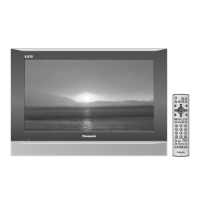
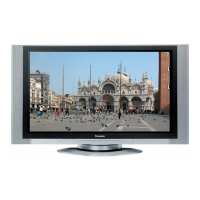

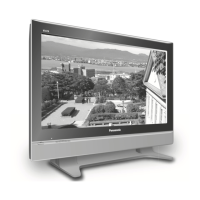
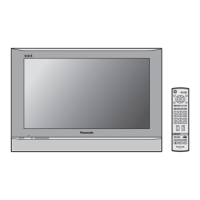


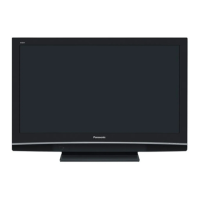
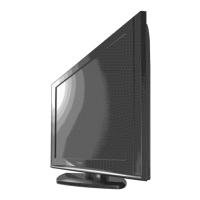
